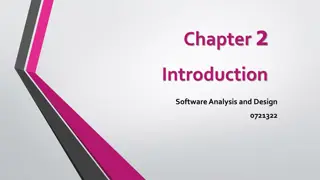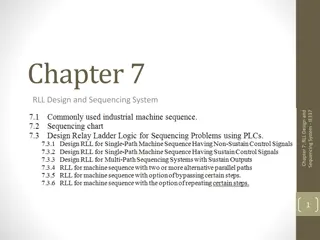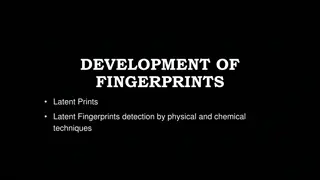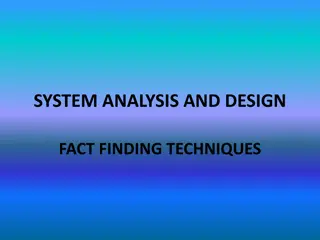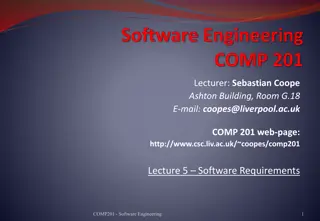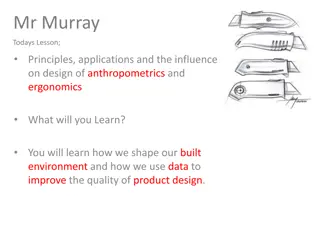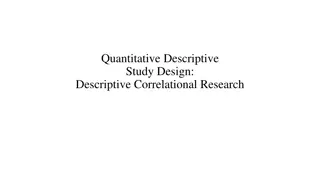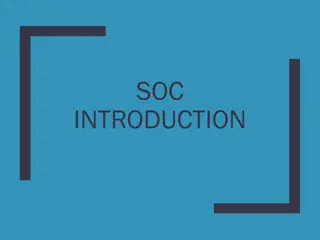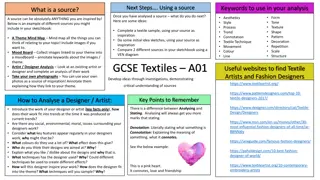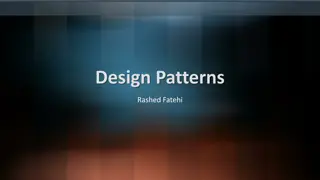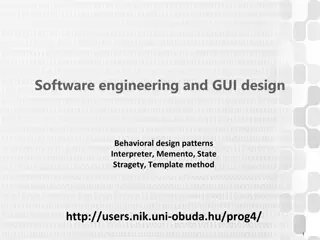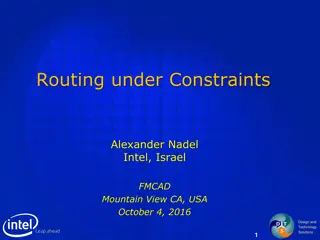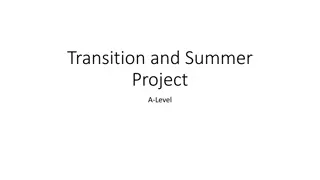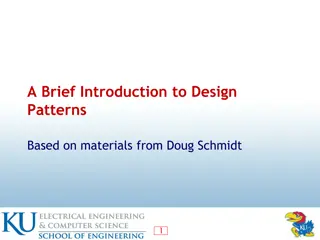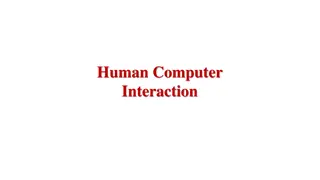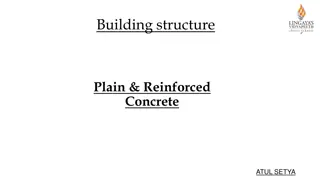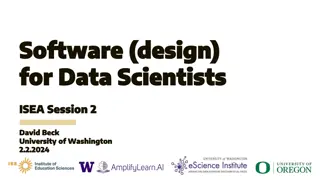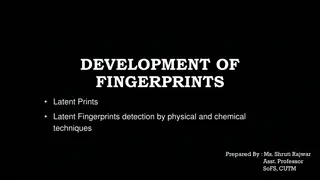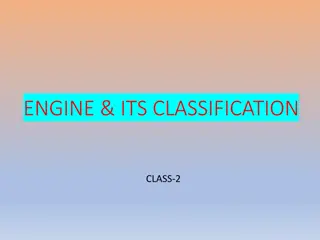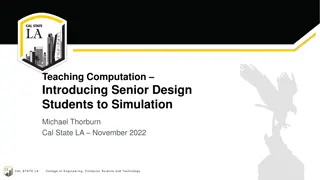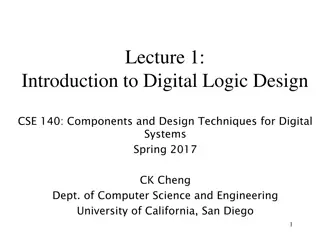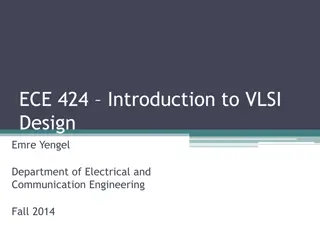Software Analysis and Design Process
Software analysis and design involve a systematic approach to understanding user requirements, creating logical models, and transitioning to detailed design specifications. Requirements analysis focuses on capturing system requirements, while design translates these requirements into implementation
8 views • 16 slides
RLL Design and Sequencing System Overview
Common industrial sequences in RLL design and sequencing systems involve single path or multi-path approaches. Control signals can be sustain or non-sustain, impacting the system's memory. Sequence charts help visualize system operations, aiding in RLL design. Techniques like the CASCADE method are
14 views • 24 slides
Fingerprint Development Techniques
Exploring the development of latent fingerprints through physical and chemical methods, conditions affecting latent prints, and various fingerprint development techniques like visual examination, powder techniques, and chemical techniques. Techniques such as alternate light sources and powder method
2 views • 22 slides
Fact Finding Techniques in System Analysis and Design
Fact finding techniques play a crucial role in collecting essential data and information for system analysis and design. Techniques include sampling existing documentation, research, observation, questionnaires, interviews, prototyping, and joint requirements planning. Extracting facts accurately is
1 views • 8 slides
Software Requirements and Design Principles
Software requirements play a crucial role in defining what a system should do, while the design describes how it achieves those goals. This lecture series covers the concepts of user and system requirements, techniques for describing system requirements, organizing software requirements in a documen
1 views • 30 slides
Anthropometrics and Ergonomics in Design
Explore the principles, applications, and design influence of anthropometrics and ergonomics. Learn how data shapes our environment and enhances product quality. Discover the significance of anthropometric data and ergonomics in design, and engage in hands-on tasks to apply these concepts practicall
1 views • 9 slides
Quantitative Research Design in Social Science
This content covers various aspects of quantitative research design, including descriptive and correlational studies, research design blueprint, robust research design considerations, and different types of research approaches. It emphasizes the characteristics, techniques, and terminologies associa
0 views • 24 slides
Guidelines for Design of Cement Concrete Pavement and Interlocking Paver Blocks
This document provides guidelines for designing cement concrete pavements and interlocking paver blocks, covering factors governing design, wheel loads, design period, subgrade characteristics, approximate k values based on CBR values, and the importance of a sub-base below concrete pavements. It em
0 views • 67 slides
Software Engineering Design Principles and Concepts
The chapter discusses the essential principles and concepts in software design, highlighting the four key design models - data design, architectural design, interface design, and component-level design. It emphasizes the importance of traceability to the analysis model, minimizing the gap between so
2 views • 36 slides
Urban Design Techniques for City Improvement
Urban design techniques play a crucial role in urban improvement by providing concepts and tools for city building. Some of these techniques include the Open Space Technique, Transportation System Technique, Capital Network Technique, Public Policies Technique, Physical Design Technique, Plug-in Tec
4 views • 11 slides
Digital Design and Publishing Techniques for Success
Explore tools for drawing shapes, learn about DTP software and document creation, discover various color application methods, evaluate DTP documents, manipulate shapes and text, create effective documents, apply charts/graphs, design folded leaflets, understand financial models, justify pricing stra
0 views • 5 slides
Software Architecture Design Principles and Techniques
Exploring the systematic approach of architecture design in software engineering, this content covers foundational principles, design decisions, allocation of responsibilities, coordination, resource management, technology choices, and best practices. It emphasizes starting with requirements, applyi
0 views • 37 slides
System on Chip (SoC) Design and Components
Explore the world of System on Chip (SoC) design, components, and working flow. Learn about Intellectual Properties (IP), platform-based design, typical design flows, top-down design approach, and the emerging Electronic System Level (ESL) design flow. Discover the essential components of an SoC, su
0 views • 45 slides
Design Inspiration and Elements in Costume and Fashion Design
Dive into the world of costume and fashion design through a visual journey of finding design inspiration, understanding the design process, emphasizing originality, and exploring different sources of creativity. Discover how technology, art, food, history, architecture, and nature can spark innovati
0 views • 45 slides
Enhancing Piping Design Efficiency with Spec-Driven Technology
Explore how Spec-Driven Piping technology powered by CADACTIVE offers a standardized approach for piping design in Creo Parametric. This innovative extension streamlines design communication, eliminates errors, and improves design efficiency by utilizing a master catalog, automated checking capabili
0 views • 15 slides
Textile Design: Sources and Techniques
Dive into the world of textile design with a variety of sources for inspiration and key techniques to enhance your creations. Learn how to analyze different sources, create textile samples, sketch initial ideas, and refine your work through evaluation and experimentation. Discover the endless possib
0 views • 4 slides
Material Design: Combining Classic Design Principles with Technological Innovation
Material Design is a design language that combines traditional design principles with the possibilities offered by technology and science. It emphasizes visual language, classic design elements, and innovation to create delightful user experiences. The Material Metaphor, Imagery, Typography, Color,
0 views • 34 slides
Comprehensive Guide to System Design Components and Techniques
System design involves the detailed planning and identification of components in an information system, aiming to provide users with a general understanding of the new system. This process includes techniques like flowcharts, prototyping, and component design, covering aspects such as output design,
0 views • 24 slides
Design Patterns: A Comprehensive Overview
Exploring the world of design patterns, this content delves into the essence of design patterns, their application in software design to resolve complexity, and the different types of design patterns - creational, structural, and behavioral. It also showcases examples of popular design patterns such
0 views • 22 slides
Guide to Behavioral Design Patterns in Software Engineering and GUI Design
Learn about key behavioral design patterns such as Interpreter, Memento, State, Strategy, and Template Method in software engineering and GUI design. Understand their purposes, implementation techniques, and when to use them effectively. Explore how these patterns enhance the design and functionalit
0 views • 42 slides
Basic Concepts in Software Design
Software design involves transforming customer requirements into a form suitable for implementation, with activities categorized into preliminary and detailed design stages. High-level design focuses on module identification and control relationships, while detailed design entails defining data stru
1 views • 24 slides
Design Solutions for Routing under Constraints by Alexander Nadel
Alexander Nadel from Intel presents design solutions for routing under constraints, addressing challenges in formalization, scalability, decision strategies, conflict analysis, and violation resolution in industrial router design. The approach involves problem formalization, SAT encoding, net restar
0 views • 42 slides
Introduction to Algorithms and Sorting Techniques
Brute force and exhaustive search are fundamental problem-solving approaches in algorithm design, while selection sort and bubble sort are common sorting techniques. Brute force involves solving problems directly based on the problem statement, with the computer carrying out the computations. Select
0 views • 18 slides
3D Design and Critical Analysis in Architecture
Dive into the world of 3D design and critical analysis with a focus on architecture. Discover the stages of design, essential skills for designers, and areas of study in three-dimensional design. Delve into iconic buildings like Frank Lloyd Wright's Falling Water, analyze their key features, and eve
0 views • 9 slides
Design Patterns in Object-Oriented Design
Design patterns in object-oriented design (OOD) are essential templates that codify best practices for solving common problems. They help streamline development by capturing proven design decisions, promoting code reuse, and enhancing system flexibility and modularity. Learn about the core concepts,
0 views • 20 slides
MDP Technical Meeting #5 on 20 T Hybrid Magnet and Comparative Analysis
The MDP Technical Meeting #5 focuses on the conceptual design and comparative analysis of a 20 T hybrid HTS-LTS magnet. Goals include defining design criteria, exploring different design options, stress management techniques, and integrating LTS/HTS technologies. The working group aims to provide in
0 views • 46 slides
Interaction Design in Human-Computer Interaction
Interaction design focuses on creating interactive products that are easy, effective, and enjoyable to use. It aims to reduce negative user experiences while enhancing positive ones. Designing interactive products requires understanding user activities, interfaces, and device arrangements to support
0 views • 11 slides
SE2811 Software Component Design Overview
This course covers software component design, design patterns, object-oriented design, algorithms, and opportunities for reuse in systems design. It emphasizes the importance of domain-level design and provides insights into solving core problems through reusable classes.
1 views • 21 slides
Analysis of Bunch Lengthening in CEPC for Different Design Parameters
This study explores bunch lengthening in the Circular Electron Positron Collider (CEPC) for various design parameters, analyzing a 54 km design scheme, a 61 km design scheme, and a 100 km design scheme. The analysis includes the theoretical framework used, equations for bunch lengthening, and conclu
1 views • 15 slides
Plain & Reinforced Concrete Structures in Design Engineering
In the design of Plain & Reinforced Concrete structures, various strength design methods such as Ultimate Strength Design (USD) and Allowable Strength Design (ASD) are utilized. These methods involve factors of safety, material strength, load factors, and analysis in the elastic range. Additionally,
0 views • 11 slides
Verilog Adder Examples & Typical IC Design Flow
This comprehensive content delves into Verilog adder examples, typical IC design flow, physical design considerations, and examples of OpenGL ES GPU and ARM hypervisor applications. It covers the fundamentals of digital logic with Verilog design, hardware description language, FPGA prototyping, phys
1 views • 27 slides
The Importance of Software Design for Data Scientists
Today's ISEA Session 2 with David Beck from the University of Washington delves into the critical role of intentional software design for data scientists. The session covers the software design approach, user-centric design stories, use cases, components, testing strategies, and the benefits and dra
1 views • 76 slides
High-Speed Amplifiers: Design Techniques and Considerations
This detailed document explores the design aspects of high-speed amplifiers, focusing on transimpedance designs using high-speed op-amps. It covers basic and advanced design issues, frequency response analysis, and key considerations for achieving desired performance. The content emphasizes simplifi
0 views • 44 slides
Fingerprint Development Techniques
Latent fingerprints are hidden impressions left by the friction ridges of the skin which require physical or chemical techniques for visualization. Factors affecting latent prints include surface type, touch manner, weather, humidity, perspiration, and suspect care. Techniques such as visual examina
0 views • 22 slides
Engine Classification and Design
Engine classification involves categorizing engines based on various factors such as combustion type, number of strokes, cylinder design, and ignition method. Common classifications include external and internal combustion engines, as well as categories based on the design and use of the engine. Add
0 views • 11 slides
Comprehensive Guide for Teaching Computation in Senior Design - Cal State LA
Join Michael Thorburn at Cal State LA as he introduces senior design students to simulation and computational techniques. Explore the role of computation in engineering senior design, ABET requirements fulfillment, project-based learning, industrial partnerships, and workforce preparation. Discover
0 views • 18 slides
Analytical Techniques in Pharmaceutical Analysis
Analytical techniques play a crucial role in determining the identification and concentration of chemical substances in pharmaceutical analysis. Techniques range from simple gravimetric analysis to sophisticated methods using specialized instrumentation. Various techniques like gravimetric, titrimet
1 views • 17 slides
Introduction to Digital Logic Design - CSE 140 at UCSD
This content provides information about the Introduction to Digital Logic Design course (CSE 140) at the University of California, San Diego for the Spring 2017 semester. It includes details about the instructor, TAs, tutors, websites, textbooks, grading policy, logistics, and class materials. The c
0 views • 38 slides
VLSI Design Methodologies and Layout Rules: A Comprehensive Overview
This detailed content provides an in-depth exploration of VLSI design methodologies and layout rules, focusing on topics such as standard cell layout methodology, transistor dimensions, design rules for n-well process, and more. The information covers important aspects like minimum widths, spacings,
0 views • 35 slides
Microscopic Techniques in Cell Biology: Lessons and Labs Overview
Explore the fascinating world of optical microscopy in cellular biology, covering topics such as image formation, contrasting techniques, fluorescence microscopy, live-imaging techniques, and quantitative microscopy. Dive into the principles behind various microscopy techniques and experimental labs
0 views • 7 slides
